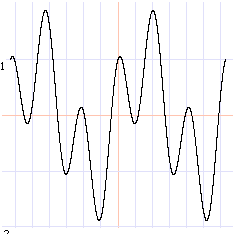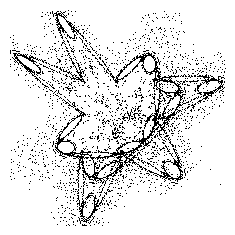As I found out to the cost of two or three marks on Question 5(A)(i) you have to do the scalings and translations in a particular order specified by the OU, an order that makes it as hard as possible to understand what is going on - the whole purpose of the exercise one might have thought.
The optimum solution understanding-wise is to apply the y translation first to get some x intercepts but if you do so it cannot be the one you want. What is all this about I wondered. Think I've got it but its still fairly amazing:
Consider a function, not the one in the question in case discussion is still off limits, Exercise Book A, Chapter A3, Exercise 2.3 (a), after completing the square we get:
|
Start with the basic parabola, y = x2 Fig (i).
Apply the y translation, y = x2 - 12 Fig (ii). The 'apex', 'minium', 'origin' of the curve moves down to (0, -12). Now we have some x intercepts. Because the curve is descending and then ascending at a rate of x2 for every x, the coresponding y manages to get from zero to -12 in √12 units of x and back up again in another √12 units. The x intercepts are at ± root 12.
|
Now apply the y scaling. We do this about where the 'apex', 'minium', 'origin' of where the curve is now, not about where it was before the translation Fig (iii).
|
With the scaling x2 is changing three times faster. Now y changes from zero to -12 for for an increase of only √12 / √3 units of x. The x intercepts are at +|- √12 / √3 which is √3√4 / √3 = √4 = ± 2, as can be seen from the graph. If the scaling was ½ or some other factor in (0, 1) this would increase the change in x needed to get from zero to -12 but we still divide by the square root of the scale factor, less than one, and ½ x2 -12 comes out as √12 / √½ = √12√2 = 2√3.√2, not such a happy calculation. Now we know where the intercepts are at ± 2, applying the x translation simply moves everything left by 3 units . The intercepts are at -2-3 = -5, 2-3 = -1 and the apex is at (-3, -12) Fig (iv).
|
Adding 3 to x inside the function makes the value submitted to the squaring three units more for any x submitted to the function itself: the x we are plotting on the graph.
Finished! No need to solve any equation, but this is too easy apparently. Solving the equation is compulsory because you are not allowed to do it by thinking.
A strategy for success
Be warned: thinking may be a 'bad thing' to do on MST121. All you had to do in this question it seems, was identify the scaling and translations and write them down in the specified order.
Scaling first is safest: a y scaling with factor 3, a horizontal translation by 3 units to the left, a vertical translation by 12 units downwards. We could do the horizontal translation first because even under OU rules a translation in the x direction has no effect on a subsequent y scaling and similarly for a y translation and an x scaling.
The TMA question asked 'Explain how the parabola that is the graph of f can be obtained from the graph of y = x2'. Personally I wouldn't class such a list as an explanation but it is all that is expected it seems, making it the sum total of what we need to know.
Having already completed the square all that is needed to find the intercepts is to solve the equation in completed square form
3(x + 3)2 - 12 = 0; (x + 3)2 = 4; x + 3 = +|- 2; x = -1 or x = -5
but, looking at the solution to Exercise 2.3 (a), even this was too easy a way.
The mystery revealed
So, what are the OU on about translation and scaling wise? A polite explanation: while translation results in linear modification of coordinates, scaling (and rotation) takes place about an origin. The further a point is from that origin the greater the effect. Consider a y scaling factor of 3 applied to a point (1, 1): after scaling the point ends up at (1, 3), a displacement of 2 units. A point already at (1, 3) ends up at (1, 9) a displacement of 8 units. The scaling has no effect on a point at (0, 0) or (1, 0) for a y scaling. These points remain where they are. If the translation is done first and its origin relocated the scaling must still be applied about the global origin, or so says the OU. The result is a function
Where my concept of scaling and the OU's differed (and still does) relates to the possibility of a local origin, in this case the point on the curve where it passed through the global origin before any translations. I am certainly not alone here - the process for scaling or rotating a curve (or anything else) with global coordinates about a point other than the global origin is known as 'translation to the origin', and back again after the scaling or rotation has been done.
We can look at this in two ways: either the centre of scaling/rotation is moved to the global origin taking all points on the curve with it by subtracting the global x y offsets of the centre from their coordinates or we can view the same process as translating the points into a new frame of reference with the centre as its origin, the result is the same and an inverse translation must be applied to get back to the same frame of reference as before.
Come on OU, if this possibility is excluded Lara Croft would never be able to turn around. If she tried to do so she would simply precess in an arc about image (0, 0, 0) and if she turned 180 degrees would end up off-screen in the universe of negative offsets. With regard to scaling, as she moved away from image-origin the heaving of her decolletage would become ever more spectacular - quite spectacular enough as it is I think.
(In fact Lara will have her own local origin and a set of numerous other local origins about which she can rotate or scale parts of her anatomy as required: quoting her here is for illustrative purposes only)
So, MST121 is (again) presenting a very limited view, in relation to translation and scaling this time. What I would like to know is where in the 'Chapters' is there any explanation of this view, perhaps similar to my one paragraph explanation above.
The diagrams were done with a quick program I wrote to investigate the effect of changing constant values in a function. Bit late now but I will post it on the Chat forum shortly in case anyone else would like to give it a try:
 |
 |
||
sin + cos : th = -2...2pi, a = 1, b = 1, c = 1, d = 1, e = 1, f = 1, n = 3 |
Martin's Map : x = 2 1/2, y = 3, a = 988/1000, b = 1 234/1000, r = 37 |